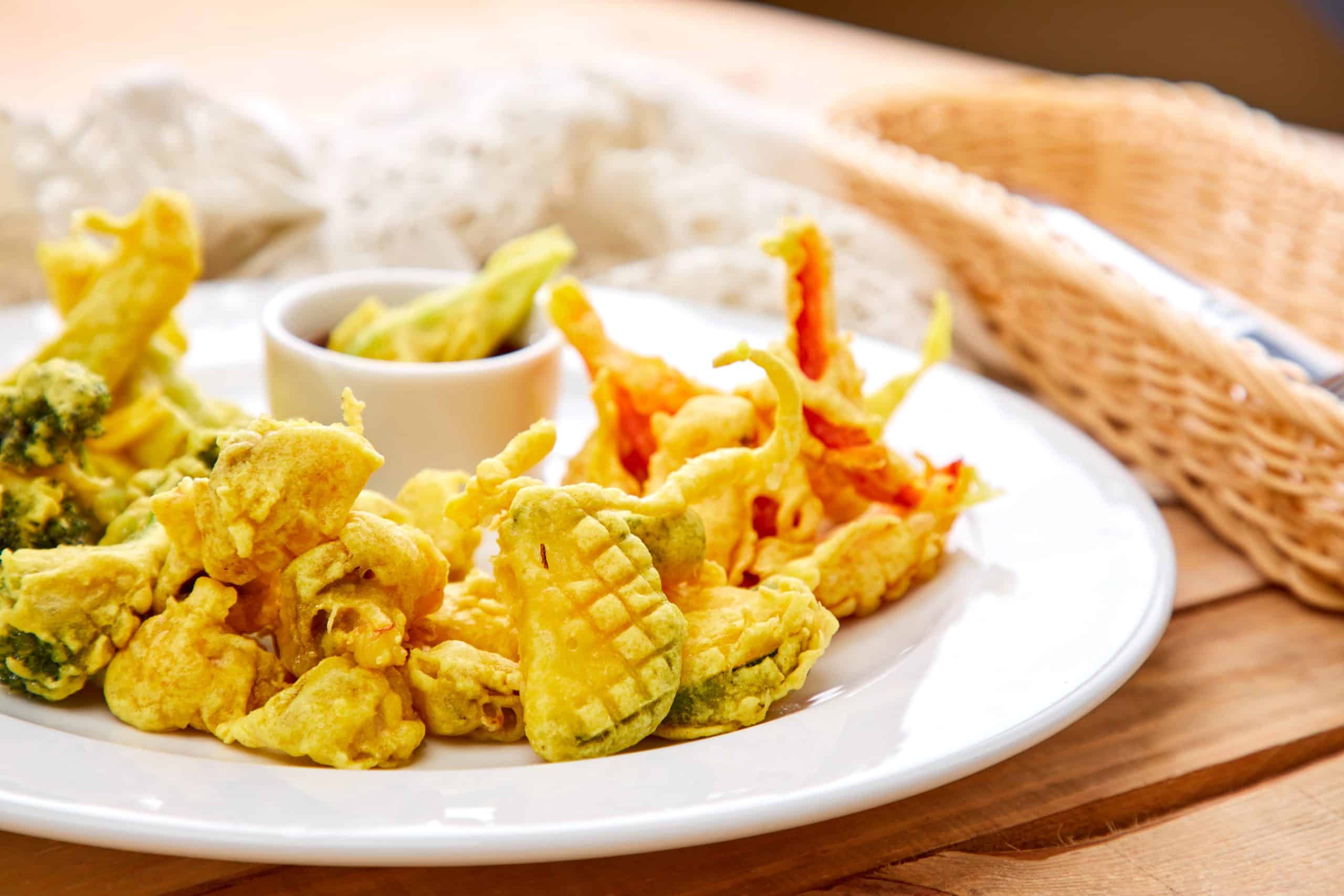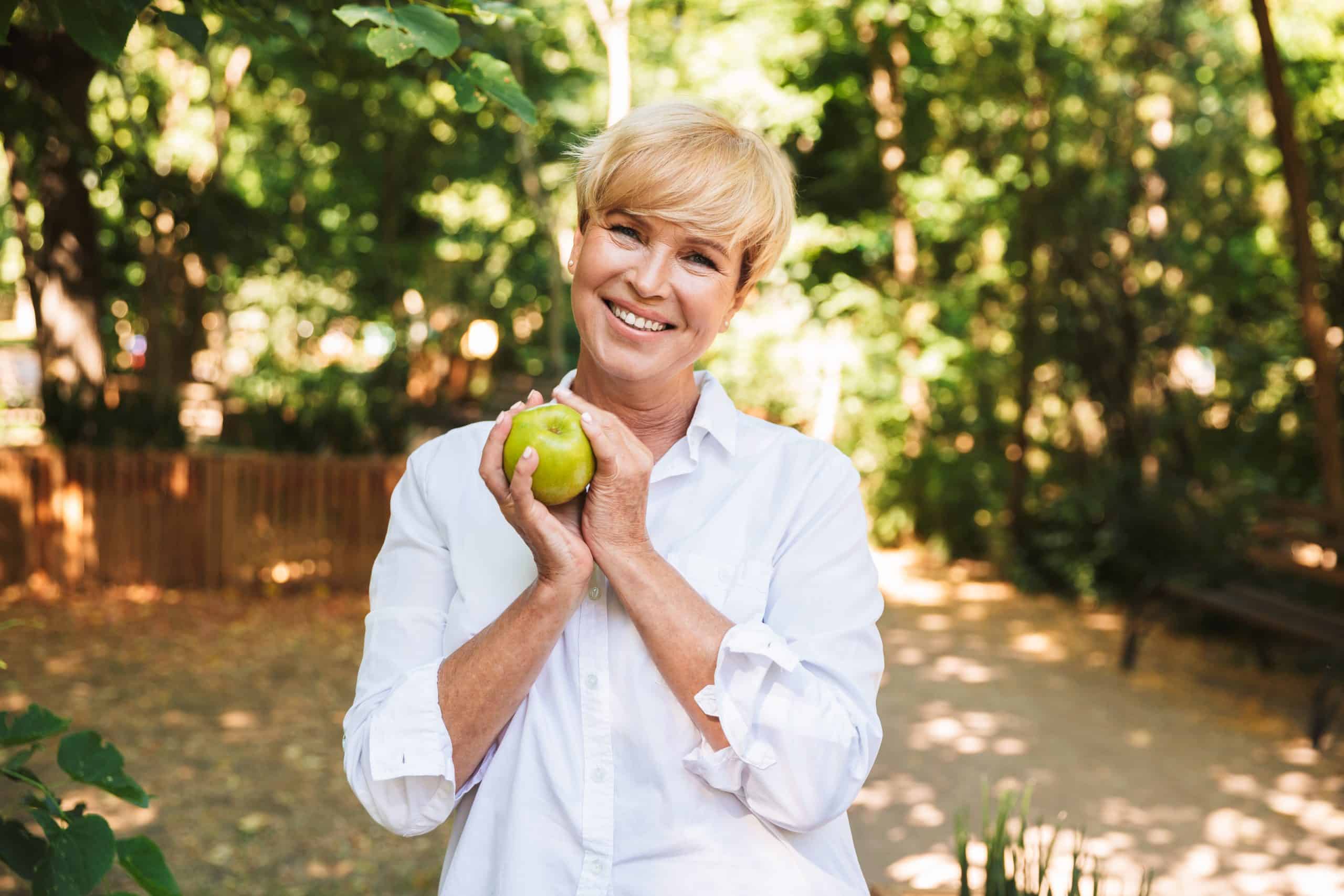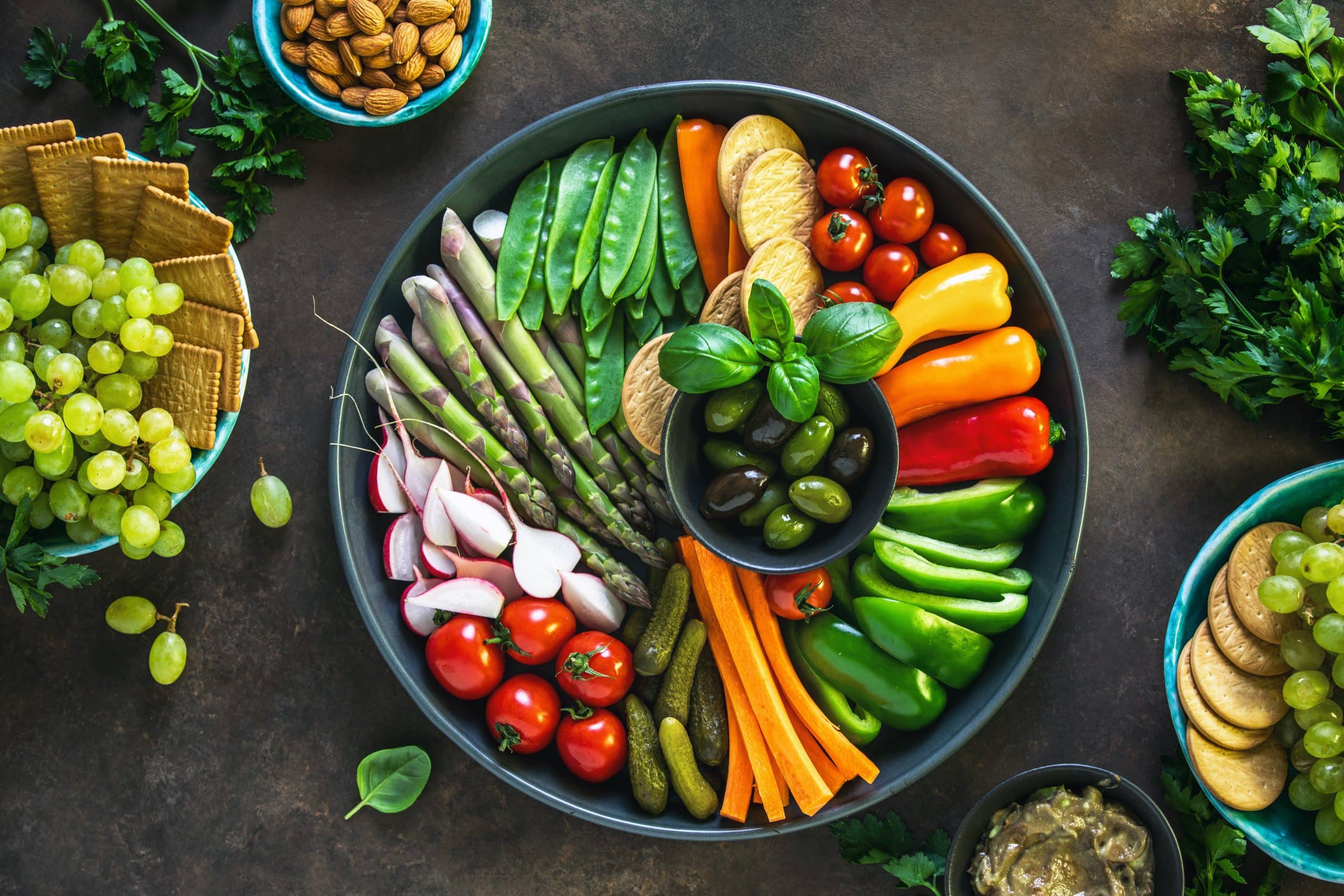Japanese cuisine is renowned for its elegant simplicity and exquisite flavors, none more than the crunchy delight of tempura.
These deep-fried morsels (traditionally seafood or vegetables coated in a light, crispy batter), are a testament to the idea that sometimes the simplest ingredients yield the most satisfying results.
As far as being vegan, conventional tempura often poses a challenge, due to the use of eggs in the batter and non-vegan elements in the dipping sauce.
But as usual, the plant-based culinary world is full of innovative solutions to replicate this classic dish without compromising on taste or texture.
We’ve scoured the web for recipes that have cracked the code for creating a vegan tempura that is as crispy and delicious as its traditional counterpart.
But first, let’s answer a few questions to better understand this dish and its plant-based adaptation.
What is Tempura?
Tempura is a Japanese dish that refers to battered and deep-fried seafood or vegetables.
The batter used in traditional tempura is light and airy, made from flour, egg, and water.
The keys to achieving the perfect tempura are in the temperature of the oil, the ratio of ingredients in the batter, and the technique used for frying.
The result is a crunchy exterior with a tender interior that enhances the natural flavors of the main ingredient.
Dropping pounds by the dozens without putting yourself through the wringer is everyone’s weight loss pipe dream. But what if we told you that the BetterMe app can make that happen? Keep yourself in prime shape with our fat-blasting workouts, delicious budget-sparing recipes, and body-transforming challenges with our app!
What Is The Main Ingredient In Tempura?
The main ingredient in tempura is the batter. The batter isn’t your typical flour and water mix, as it also includes a leavening agent like baking powder, egg yolks, rice wine or sake, and ice-cold water.
The batter should be light and airy to achieve the signature crunchy texture of tempura.
Tempura batter can be quite forgiving, in the sense that you’re free to tweak the measurements of ingredients to achieve your preferred texture and flavor.
In fact, some recipes even include carbonated water or beer for an extra crispiness.
Why Is Tempura Not Vegan?
Tempura isn’t vegan because the batter usually contains egg and the dipping sauce, known as tentsuyu, often contains dashi (a Japanese fish broth) or soy sauce made from fermented fish.
In addition, seafood like shrimp, squid, and fish are commonly used for making tempura.
Vegan tempura can be made by substituting eggs with plant-based alternatives, such as flax eggs or aquafaba (the liquid from a can of chickpeas).
There are also many recipes that use non-dairy milk instead of water to create a thicker and creamier batter.
For the dipping sauce, soy sauce is usually used as the base, and there are also vegan options available in stores or homemade versions using ingredients like miso, sake, and mirin.
What Is Vegetable Tempura Batter Made Of?
Vegetable tempura batter is essentially the same as regular tempura batter, with some consideration for the potential sogginess of certain vegetables.
To combat this, some recipes suggest lightly salting the vegetables to remove excess moisture before battering and frying.
Another trick is to coat the vegetables with a light dusting of cornstarch or rice flour to absorb any residual moisture.
Is Veggie Tempura Healthy?
Coating vegetables in a batter and then deep-frying them may not sound like the healthiest option, but in moderation, veggie tempura can still be a nutritious snack.
The key is to use high-quality ingredients and maintain control over portion size.
For one, your choice of veggie matters. One of the most popular plant-based alternatives for traditional seafood tempura is with vegetables like sweet potatoes, mushrooms, zucchini, and bell peppers.
These vegetables hold up well to the frying process and provide a burst of flavor and texture. Other delicious plant-based options include tofu, avocado, and even tempeh.
Additionally, using a high smoke point oil like avocado oil for frying can be healthier compared to other oils that may break down at high heat. Fry the tempura at a higher temperature to cook it quicker and reduce the time for oil absorption, or try a version in the air fryer.
As for the batter, much can be done to make it healthier.
For starters, keeping it simple by using just flour and water without any calorie-dense additives like eggs or dairy is a great way to go.
You can also experiment with whole grain flour, gluten-free flour, and alternative milk options like almond or coconut to meet any dietary requirements.
Adding herbs and spices like garlic powder, onion powder, cayenne pepper, or even nutritional yeast can add both flavor and nutrition to the batter.
And finally, moderation is always key when it comes to fried foods. Enjoy your veggie tempura in small portions as an occasional treat, and balance it out with a side of fresh salad or steamed vegetables.
Check out our Healthy Thai Food collection to see how you can get the best of both worlds with delicious, plant-based versions of your favorite Asian dishes.
Read more: Vegan Falafel Recipe: A Step-by-Step Guide to Crispy Goodness
Tips for Achieving the Perfect Vegan Tempura
Although making vegan tempura may seem intimidating, there are a few tips that can help ensure success.
- Make sure to use ice-cold water when making the batter to achieve a light and crispy texture.
- Don’t overmix the batter, as this will result in a tough and chewy tempura.
- Lightly salt your vegetables before battering to remove excess moisture.
- While salting, also make sure to pat dry the vegetables after rinsing to remove any excess water.
- Use a high smoke point oil like avocado or grapeseed oil for frying.
Use a deep-frying thermometer to monitor the temperature of the oil, ideally between 350-375 degrees Fahrenheit.
Don’t overcrowd the frying pan as it will lower the temperature of the oil and result in soggy tempura. Instead, fry in batches and drain on a wire rack or paper towels to maintain the crispiness.
Serve your vegan tempura immediately after frying to ensure maximum crunchiness.
Easy Vegan Tempura Recipe (1)
This vegetable tempura recipe isn’t called easy for no reason. The batter is made from simple ingredients, and the instructions are straightforward with room for experimentation.
Vegan shrimp might just make the perfect batter-tester, and in case you don’t know how to prepare them, you can buy vegan shrimp at online stores like Amazon or your local health food store.
(They’re not the same as prawns, which are usually used in non-vegan tempura.) This recipe works equally well with eggplant, sweet potato, broccoli and mushroom.
Ingredients:
- 50 g (1/3 cup) cornstarch
- 35 g (1/4 cup) flour
- 10 g (2 tbsp) rice flour
- 1 tsp (3 g) baking powder
- 1/2 cup sparkling water
- Oil for frying
- Vegetables of choice/vegan shrimp
Instructions
- In a medium-sized mixing bowl, whisk together the dry ingredients: cornstarch, flour, rice flour, and baking powder.
- Slowly drizzle in sparkling water while stirring continuously until a smooth batter forms.
- If the batter seems too thick, add more sparkling water gradually until the desired consistency is achieved.
- Add your choice of vegetables or vegan shrimp to the batter, ensuring they are evenly coated.
- Heat oil in a deep frying pan until it reaches 350-375 degrees Fahrenheit.
- Using tongs or chopsticks, carefully place the battered vegetables into the hot oil, one at a time, making sure not to overcrowd the pan.
- Fry for approximately 2-3 minutes or until the batter turns golden brown and crispy.
- Remove from oil and place on a wire rack or paper towel to drain excess oil.
- Serve hot with your choice of dipping sauce (traditional soy sauce or vegan options).
Nutrition
The recipe makes 6 servings
Calories 323 Calories from Fat 170
Fat 18.9g | Saturated Fat 3.2g | Sodium 513 mg | Potassium 318 mg | Carbohydrates 33.8g | Fiber 3.3g | Sugar 4.7g | Protein 5.8g | Calcium 30 mg | Iron 2.7mg
Want to build an attention-grabbing bubble butt, blast away fat that’s stored in all the wrong places, spring-clean your diet, turn back the clock on your skin, skyrocket your self-confidence and shatter your insecurities? Check out the BetterMe app and set this plan in motion!
Beer Tempura Recipe(1)
Making your vegan tempura batter without sparkling water is easy when you have a can of cold beer. The carbonation in the beer creates a light and airy batter, perfect for deep-frying your choice of vegetables or vegan protein.
Plus, knowing you can quickly whip a snack with this easy no egg no sparkling water tempura batter recipe could be a lifesaver.
Ingredients
For the Batter
- 1 ½ cups all-purpose flour
- 1 ½ cups beer (pale ale, pilsner, or another light beer), chilled
- ½ teaspoon salt
- ½ teaspoon baking powder
For the Tempura Vegetables
- ½ cup peanut oil, or another high smoke point oil such as canola, plus more as needed
- 1 small sweet potato, sliced into ¼ inch thick slabs
- 1 small broccoli crown, broken into small florets
- 10 asparagus spears, woody ends trimmed
- ½ large onion, sliced into thin strips or rings
Instructions
- In a large mixing bowl, whisk together the flour, beer, salt, and baking powder until smooth.
- Heat oil in a deep frying pan over medium-high heat.
- Dip your choice of vegetables into the batter, making sure they are evenly coated on all sides.
- Carefully place them into the hot oil, one at a time, and fry for approximately 3-4 minutes or until the batter is golden brown and crispy.
- Remove from oil and place on a wire rack or paper towel to drain excess oil.
- Serve hot with your choice of dipping sauce (traditional soy sauce or vegan options).
Read more: Vegan Dumplings – A Taste of Compassion In Every Bite
Vegan Tempura Sauce Recipe (2)
No tempura is complete without a delicious dipping sauce. This vegan version of the traditional soy-based tempura sauce is easy to make and tastes just as good, if not better! Plus, it can easily be customized to suit your taste preferences.
Ingredients
- 2 tablespoons soy sauce
- 1 tablespoon maple syrup
- ½ teaspoon toasted sesame oil
Instructions
- In a small mixing bowl, whisk together the soy sauce, maple syrup, and toasted sesame oil until well combined.
- Adjust ingredients to taste if desired (add more maple syrup for sweetness or soy sauce for saltiness).
- Serve alongside your freshly made vegan tempura for dipping and enjoy!
Our post titled Is Soy Sauce Keto-Friendly reviews its nutrient profile and can help you make an informed decision on using soy sauce in your dip.
FAQs
What Vegetables Can Be Used for Tempura?
Almost any vegetable can be used for tempura, but some popular options include eggplant, sweet potato, broccoli, asparagus, onion, and mushrooms.
Why Is Tempura Unhealthy?
Tempura may be considered unhealthy because it is typically deep-fried, which can add excess calories and fat to the dish. However, by using healthier frying oils and moderating portions, tempura can still be a delicious treat in moderation.
Why Is Sushi Not Vegan?
Sushi is not always vegan because it often contains fish or seafood. However, some sushi restaurants offer vegetarian or vegan options using ingredients like avocado, cucumber, and tofu instead of animal products. It’s always best to check with the restaurant before ordering to ensure your dietary needs are met.
Check out this piece on Homemade Sushi Recipes to discover how easy it is to make your own vegan sushi at home!
The Bottom Line
Vegan tempura is a delicious and easy snack or side dish that can be made with a variety of vegetables and vegan proteins. With these tips and recipes you can now confidently make your own crispy tempura at home. Choose your favorite vegetables, experiment with different batters and dipping sauces, and enjoy the deliciousness of vegan tempura.
DISCLAIMER:
This article is intended for general informational purposes only and does not serve to address individual circumstances. It is not a substitute for professional advice or help and should not be relied on for making any kind of decision-making. Any action taken as a direct or indirect result of the information in this article is entirely at your own risk and is your sole responsibility.
BetterMe, its content staff, and its medical advisors accept no responsibility for inaccuracies, errors, misstatements, inconsistencies, or omissions and specifically disclaim any liability, loss or risk, personal, professional or otherwise, which may be incurred as a consequence, directly or indirectly, of the use and/or application of any content.
You should always seek the advice of your physician or other qualified health provider with any questions you may have regarding a medical condition or your specific situation. Never disregard professional medical advice or delay seeking it because of BetterMe content. If you suspect or think you may have a medical emergency, call your doctor.










